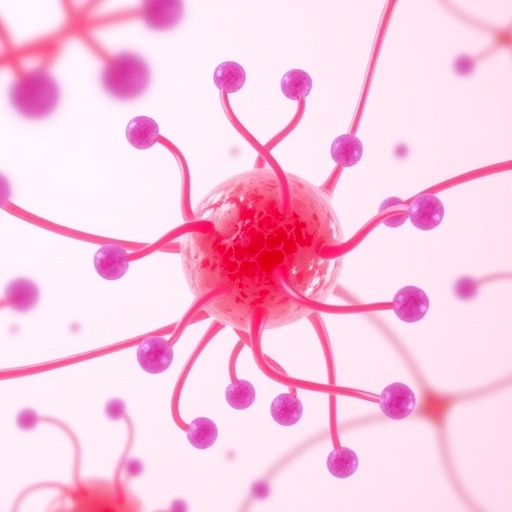A groundbreaking study published in the latest volume of Oncotarget illuminates a promising new frontier in the fight against breast cancer, particularly focusing on cases resistant to aromatase inhibitor (AI) therapy. AI resistance — a notorious clinical challenge — often leaves patients with limited treatment options once standard endocrine therapies fail. This innovative research introduces polyisoprenylated cysteinyl amide inhibitors (PCAIs) as a potential game-changing approach for overcoming this resistance, leveraging multifaceted mechanisms targeted at cellular survival and structural integrity.
The study’s centerpiece is NSL-YHJ-2-27, a PCAI compound that demonstrates remarkable effects in models of AI-resistant breast cancer cells — specifically, long-term letrozole-treated breast cancer cells (LTLT-Ca). These cells, which mimic the adaptive behavior of tumors that have evolved past AI therapy effectiveness, represent a formidable obstacle in clinical oncology. However, the introduction of NSL-YHJ-2-27 elicits an unexpected and lethal overstimulation of critical signaling pathways, namely MAPK and PI3K/AKT, which are typically known to promote tumor survival and proliferation.
MAPK and PI3K/AKT pathways usually act as cellular life-support systems, helping cancer cells thrive under stress. The intriguing paradox highlighted by this research lies in the excessive activation of these pathways by NSL-YHJ-2-27, which instead triggers a cascade of oxidative stress within the cancer cells. This elevated oxidative environment leads to reactive oxygen species (ROS)-mediated apoptosis, a form of programmed cell death, effectively turning the cancer cells’ own survival machinery against them. This discovery challenges the traditional dogma and opens a novel therapeutic avenue by co-opting pathways conventionally considered oncogenic.
Further molecular dissection of NSL-YHJ-2-27’s action revealed a concomitant downregulation of RAC1 and CDC42 — small GTPases instrumental in maintaining cell morphology, motility, and the dynamic remodeling of the cytoskeleton. By suppressing these proteins, the compound disrupts actin filament networks and compromises focal adhesions, integral components required for cell shape and attachment. This disruption undermines the structural scaffold cancer cells rely on for migration and invasion, thereby reducing their metastatic potential. The visual evidence from fluorescence microscopy, with notable retraction of lamellipodia and delocalization of adhesion proteins such as vinculin and fascin, corroborates these biochemical findings.
This dual assault on signaling and structural domains is instrumental in the compound’s efficacy. NSL-YHJ-2-27 was observed to inhibit cell proliferation by an impressive 95% and reduce colony formation by 74%. It also triggered increases in apoptotic markers such as caspase 7 and BAX by 1.5-fold and 56%, respectively. Notably, treatment with the compound at 10 micromolar concentrations induced spheroid degeneration in LTLT-Ca models by 61%, reflecting its potency in three-dimensional cell culture systems that better recapitulate tumor architecture.
An especially compelling aspect of the findings is the persistent effect of NSL-YHJ-2-27, which continues to exert its anti-cancer influence even after its removal from the cellular environment. This suggests potential for durable clinical responses and long-lasting control over AI-resistant breast cancer progression. The ability to “lock” resistant cancer cells into a dysfunctional state could have transformative implications for managing treatment-resistant malignancies.
Importantly, this research sets PCAIs apart from conventional endocrine therapies by targeting key intracellular signaling and structural processes simultaneously. While most hormonal treatments focus exclusively on estrogen signaling suppression, PCAIs engage multiple cellular targets, leveraging oxidative stress induction and cytoskeletal destabilization to achieve their therapeutic effect. This multipronged mechanism not only enhances efficacy but may also reduce the likelihood of resistance development during treatment, a chronic issue with monotherapies.
The authors employed state-of-the-art techniques including immunofluorescence staining with Alexa Fluor™ conjugated phalloidin and antibodies to scrutinize the impact of PCAIs on actin filaments and focal adhesion complexes. Microscopic analyses showed marked collapsing of actin filaments and loss of adhesion punctates, visualized as decreased vinculin and fascin localization. Western blot quantification further validated these observations, confirming a dose-dependent reduction in these proteins critical for cellular adherence and migration.
From a translational perspective, these findings highlight an innovative strategy for combating one of the most vexing hurdles in breast cancer therapy — acquired resistance to AI drugs. Considering that resistance mechanisms often involve compensatory activation of survival pathways and cytoskeletal adjustments facilitating invasiveness, the ability of PCAIs to simultaneously disrupt both survival signals and structural integrity is exceedingly promising.
Future research directions outlined by the study emphasize the necessity of in vivo validation to confirm efficacy and safety in whole-organism systems. Additionally, clinical trials will be essential to determine therapeutic windows, dosage optimization, and potential combinatorial strategies alongside existing treatments. The novelty of PCAIs also opens investigative routes into their effects on other cancer subtypes characterized by similar resistance and cytoskeletal dependencies.
The implications of this work stretch beyond breast cancer, heralding a broader application of PCAIs as modulators of signal transduction and cytoskeletal dynamics in oncology. By unveiling a non-traditional pathway for inducing cancer cell death through ROS-mediated apoptosis coupled with structural destabilization, this study lays the groundwork for a new paradigm in targeted cancer therapy.
This research, spearheaded by Jassy Mary S. Lazarte and corresponding author Nazarius S. Lamango of Florida A&M University College of Pharmacy and Pharmaceutical Sciences, stands as a beacon of hope for patients grappling with resistant breast cancers. The innovative approach and robust preclinical results mark a significant step forward in addressing unmet clinical needs and expanding the arsenal against one of humanity’s most persistent diseases.
As the scientific and medical communities continue to evolve treatment strategies, the discovery of PCAIs and compounds like NSL-YHJ-2-27 represents a beacon for tailored, mechanism-driven therapy. The capacity to exploit cellular vulnerabilities in signaling and structural machinery using such molecular tools promises to reshape the landscape of breast cancer therapeutics and inspire novel drug design paradigms.
Subject of Research: Cells
Article Title: PCAIs stimulate MAPK, PI3K/AKT pathways and ROS-Mediated apoptosis in aromatase inhibitor-resistant breast cancer cells while disrupting actin filaments and focal adhesion
News Publication Date: 29-Jul-2025
Web References: https://www.oncotarget.com/archive/v16/, DOI: 10.18632/oncotarget.28759
Image Credits: Copyright: © 2025 Lazarte et al. This is an open access article distributed under the terms of the Creative Commons Attribution License (CC BY 4.0).
Keywords: cancer, PCAIs, ROS, MAPK, PI3K/AKT, LTLT-Ca cells




